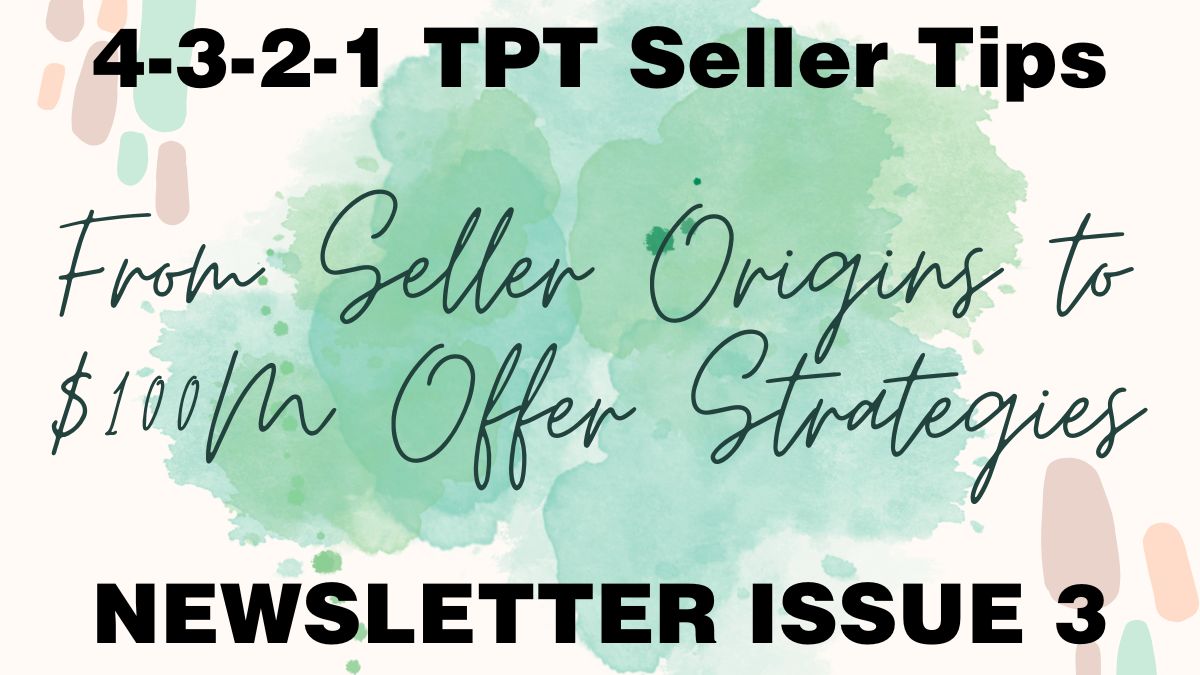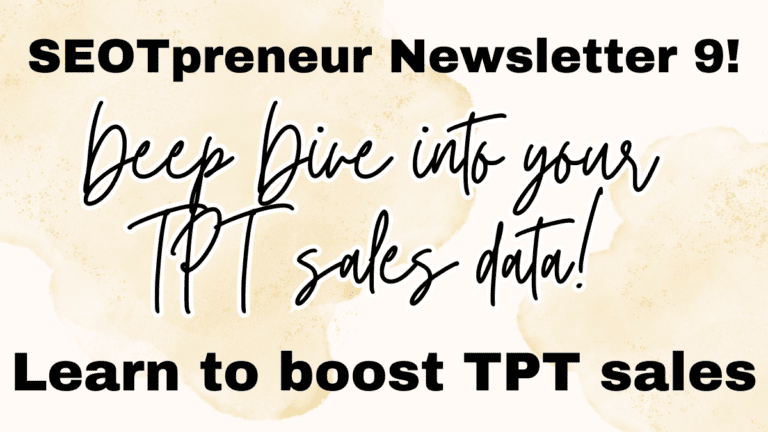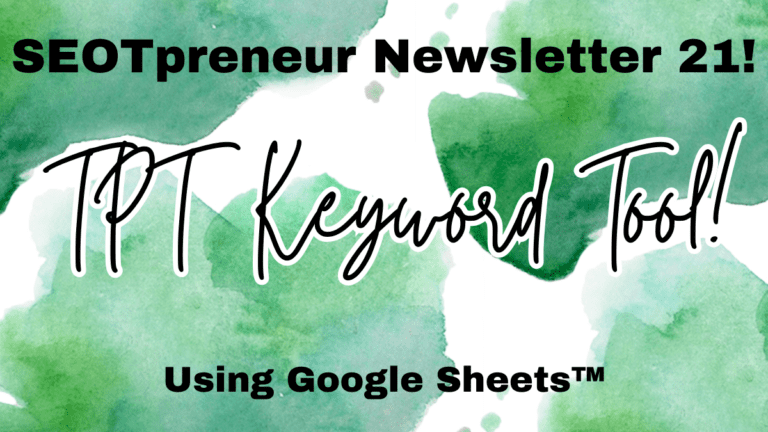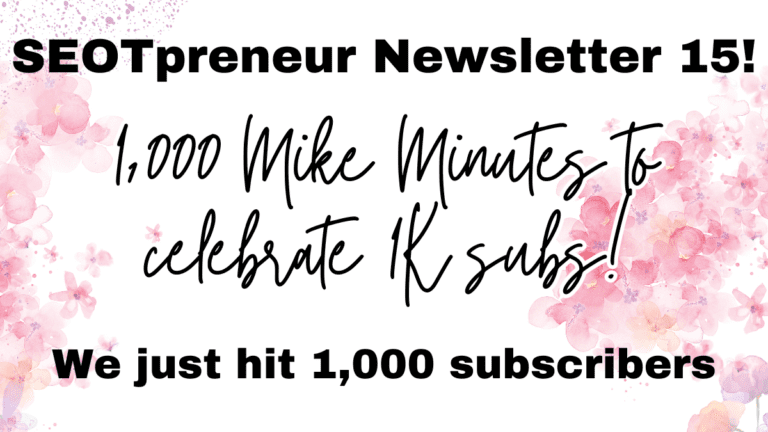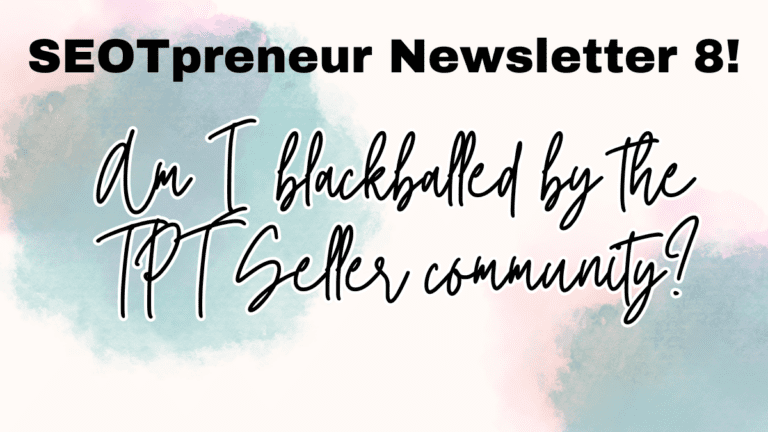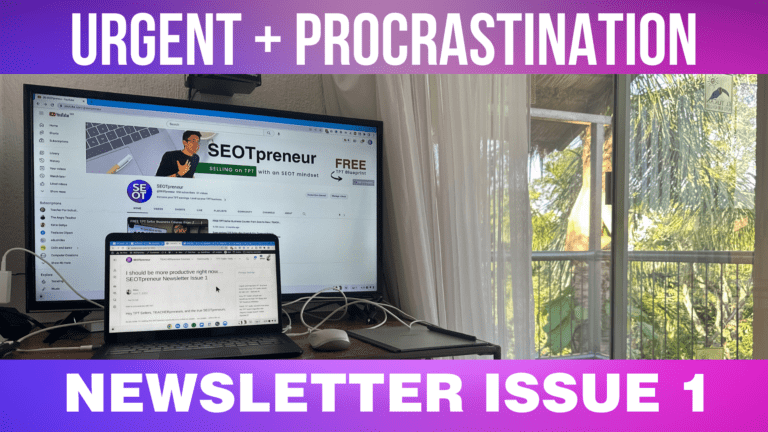Maximize Your TPT Impact: From Seller Origins to $100M Offer Strategies 🚀 4,3,2,1 TPT Seller Tips
🌟 Hello TPT Sellers! 🌟
Whether you’ve just begun your TPT journey or you’re a seasoned pro, every TPT seller’s path is unique, filled with learnings and opportunities.
Today, I’m excited to guide you through some tips specific to the different stages of a TPT Seller’s journey. (If you’re not familiar with the terms, TPT Egg, Tadpole, Hamster, and Hawk, check out this free TPT Seller Business Course.)
FOUR (4) TPT Seller Tips
If you’re a TPT Hamster: Create a FREE basic TPT Seller account.
Just start. Go to TPT and create a free basic TPT Seller account.
Take a resource that you know works well in your classroom and list it.
Your first resource has to be free. Just accept that it’s not going to be awesome (yet,) and that’s okay. Just start.
PRO TIP: For some annoying reason, you can’t unpublish your first TPT resource, so make sure you’re not uploading something you didn’t make to test the waters! You won’t be able to shift it into draft mode if you only have one product (because it has to be public and free.)
If you’re a TPT Tadpole: Think like a TPT Buyer, not TPT Seller
The biggest advice I have for TPT Tadpoles is to look at your products as if you were a teacher buyer (and not a teacher seller.)
When we start, we focus on just creating a good lesson.
But half of the battle is really explaining to potential teacher buyers how your product eases their pain. (i.e. not enough time to make this resource, or they don’t know how to make this resource.)
If you look at your best-selling product so far, I bet there are things you can do to improve the cover, preview, or product description to help teachers feel more comfortable buying from you.
Spelling mistakes and shoddy covers give teachers a reason not to buy from you.
(After all, if your product cover or description has errors, your product probably does too! Or, at least, that’s what buyers will be worried about. Wouldn’t you?)
If you’re a TPT Hamster: The more you crank that wheel, the more you’ll notice short cuts and ways to improve your product.
Find the joy in running on that content-creation hamster wheel! Seriously. The more you do something, the better you get. You start to notice little short-cuts.
For example, emailing attachments in a newsletter is a big no-no. (They tend to get blocked by email spam guards.)
So to share a PDF in your email list, instead of attaching the PDF to the email, you can upload the PDF to your Google Drive, make the file “viewable by anyone” and then share a link to the file.
Normally when a teacher clicks on a shared PDF link in Google Drive, their browser opens a PDF viewer, and they have to manually click the download button. But you can modify the link slightly so it becomes an automatic download.
I do this through custom formulas in a Google Sheet, but one day, Enrica and I were talking about her WordPress TPT Blog, and she showed me this Google Drive Direct Link Generator that she uses.
It’s way easier for most people to generate a download link for a file uploaded to Google Drive. This one little shortcut improves the user experience because now, they have a one-click link to download the attachment. (And, your email newsletter is more likely to get to the inbox because there are no attachments!)
If you create enough one-click custom links, you’ll realize it’s easier to automate the process instead of pasting the link in that website one by one. That’s where Google Sheets and custom formulas come into play. If you’re interested, let me know and I’ll try to find the time to share the Google Sheet I use.
If you’re a TPT Hawk: Focus on getting page views
The goal of a business is to make money. If you don’t have income, you don’t have a business.
Spend 30 minutes every day doing activities to get more leads in your sales funnel.
- When I do this trick for my SEOT Hosting business, I think about who is closest to making a buy decision for an SEOT hosting plan. Then I nurture that relationship by reaching out and emailing them personally.
- When I do this trick for my TPT business, I think about how can I get more people to my TPT product pages.
Think of it this way:
- If 100 people view your TPT product page, and
- 10 of those people view your product preview, and
- 1 person ends up buying your product,
- then if you get more people to view your TPT product page, you get more sales.
Yes, this is an oversimplification, but ask yourself what actions can you take right now to get more page views. No pageviews = no sales.
Let’s stop relying solely on TPT search to feed our sales funnel. Let’s go out fishing for our ideal customer avatar. Where do they hang out, and how can you get them to your TPT product page? Then spend 30 minutes per day getting them to your TPT product page.
THREE (3) Things TPT Sellers are talking about:
Want to know how much money I made during my first year as a TPT Seller?
Andrea was curious about my TPT store origin story. So, during our last Zoom Homework Club meeting, I went through my TPT dashboard, talked about how many products I had during that first year, and how much money I made.
I’ve made around $70K from my Educircles TPT store so far. But, do you want to know how much I made during year 1 and year 2? You can check out the replay here. It’s a good one!
(You need to be an SEOTpreneur PRO member to watch the replays. Is it time to turn PRO?)
Is sending out FIVE emails to your email list during a sale too little or too much?
Enrica and I did a live stream and talked about prepping for a TPT sale. (The livestreams are an experiment. We’re doing one every Tuesday at 2 PM (ET) during the summer. The next one is about TPT product covers)
One of the things that came up was how many emails do you send out during a sale. Enrica does one. (Well, she’s trying out two emails this sale based on this next comment…)
I heard a TPT Seller in the third milestone club ($500,000 in earnings) casually mention that in their mastermind group, they were exploring sending out EIGHT emails per sale!
@fleavecmmed left a comment in the SEOTpreneur YouTube community: “I sent out five sales emails. 1/3 of my earnings from the sale were from my emails. I have no regrets!”
Thanks for sharing your data with us, @fleavecmmed – I asked about how many unsubscribed – check out the rest of the comment thread.
Is going to TPT Forward in person worth it if you have to pay for airfare?
Shout out to Paula, who left a comment on my Boston TPT Forward 2023 video.
I had a blast, and even though the hotel cost around $1,000, I was able to save costs by driving down to Boston.
The big question was whether I think “attending in person is worth the added expense for someone who would also have to pay for airfare?” Check out my response to Paula here.
Have you been to a TPT Forward yet? What would it take for you to go?
TWO (2) things I’m trying right now:
On SEOTpreneur.com – Working on the Newsletter:
A repeated message I’ve heard from within the TPT Sellerverse and outside in the larger business community is the importance of an email mailing list.
So I’m trying this “4, 3, 2, 1” format for my SEOTpreneur newsletter to provide direct value to you.
If you signed up for the email newsletter, I’m guessing you want TPT seller tips and tricks.
So, I thought I’d start with those, then try to provide social proof, a little insight into what I’m trying myself, and finally, something I’ve learned from business leaders.
Why do I always quote different books I’ve read? It’s not a humble brag. Quite the opposite.
I haven’t hit the one-million-dollar mark yet. So I’m not able to share the lessons learned from all of the mistakes I’ve made to get there.
Although I might not have lived experience of getting to 7 figures (yet), I can learn from others who have done it and then apply their lessons to our TPT Sellerverse!
On SEOT hosting: Shifting from being a commodity to being unique:
I’m listening to Alex Hormozi’s $100M Offers and his approach towards differentiating yourself in the marketplace by having people focus on your value (instead of seeing you as a commodity.)
If your product is a commodity (i.e. a lesson plan) then you get compared to every other similar commodity, and the lowest price wins.
On the other hand, if you’re able to position yourself in some unique way, then you’re competing against no one. Here’s an example of how I’m trying to apply this in practice.
I used to position SEOT hosting as a commodity: web hosting.
Then my prices inevitably get compared to every other established (and cheaper) web host: Bluehost, Siteground – and I have to explain how I’m different from those options and why I’m better for TPT sellers.
Now I’m selling the same product (SEOT hosting) but repositioning it as something unique that you can only get from me: I’m selling it as Premium WordPress coaching for TPT Sellers that happens to include a year of web hosting from me (because there’s no way I’m waiting for a Bluehost server to randomly slow down to a crawl from lack of server resources.)
Same product.
Same price.
Completely different angle.
Why does this difference matter? Well, you can’t get exclusive WordPress coaching from me through Bluehost or Siteground.
And after 14+ years working with WordPress and making $70K on my TPT store, I know exactly what we need as TPT sellers when it comes to WordPress.
No other web hosting company offers Mike as your TPT Blog coach. That’s my unfair advantage. Now, figure out what your unfair advantage is with your TPT store and how can you position your products to showcase your benefits?
ONE (1) GOLD NUGGET that I learned from Business Leaders (outside of the TPT Seller space)
This gold nugget comes from listening to Dan Meredith’s book, How to be f’ing awesome.
He shares what he calls the world’s simplest business plan:
Dan Meredith’s simple business plan
- Step 1. Find a group of people in pain (i.e. teachers)
- Step 2. Research and learn about everything you can about this group of people (i.e. your specific niche: Grade 1-3 Math Teachers in your specific state or province.)
- Step 3. Create a solution that eases their pain
- Step 4. Sell it to them.
If your product is truly awesome, and you have something that could ease someone else’s pain, then you’d be a jerk not to offer it to them. Why wouldn’t you help them with their suffering?
Teachers: How do we apply this simple business plan to the TPT Sellerverse?
If you’re a teacher selling something that you use in the classroom and you know it works really well, then…
- you’ve already done Step 2: You know everything about yourself as a teacher because you’re you.
- you’ve also done Step 3. You already created a solution that eased your pain.
What’s left?
- you need to do Step 1: Find out where teachers like you hang out. Where do you go when you’re looking for resources? Facebook groups? Google search? Pinterest? TPT search? Your teaching partners? Think about your searching habits, go there and make sure teachers like you know about your product (i.e. Step 4).
People trying to get rich quick on TPT: How do we apply this simple business plan to the TPT Sellerverse?
If, on the other hand, you’re selling on TPT because you think it’s a get-rich-quick scheme and you watched another YouTuber talk about arbitrage and buying a resource from one platform, chopping it up, and re-selling it on TPT, then…
- you’ve done part of step 3 (create a solution – i.e. resource) but you haven’t figured out how it eases teacher pain.
But if you don’t have kids, and have never taught in the classroom or spent time in the education space, you probably don’t know why teachers are in pain (i.e. no time to create resources), or what teachers want.
- So, really, you need to go back to Step 1. Figure out who teachers are and why they might be in pain,
- And then Step 2. Really research that group of people (i.e. your specific niche of teacher) to figure out a solution to their specific pain.
PRO TIP: You can’t sell to “all” teachers. For example, primary school teachers have very different needs and pain points than middle school teachers. You couldn’t pay me enough to try to teach Grade 1 and be responsible to have students “reading” by the end of the year. On the other hand, I thrive in a Grade 8 classroom where students act all tough and cool, but for the most part, they still want to try. If you can hook them, you can have incredibly engaging conversations and powerful learning moments.
There are primary school teachers reading this and thinking you couldn’t pay them enough to teach in the trenches of middle school with those wild tweens and teens.
Feedback, Please!
What did you think of this email newsletter? Was it useful?
Did I mention something you hadn’t considered before?
If you have time, can you leave feedback about this “4,3,2,1,done!” newsletter format on this YouTube video about building a TPT Seller Community: https://youtu.be/0YDTPna2Na4
See you in the next comment! Cheers, Mike

